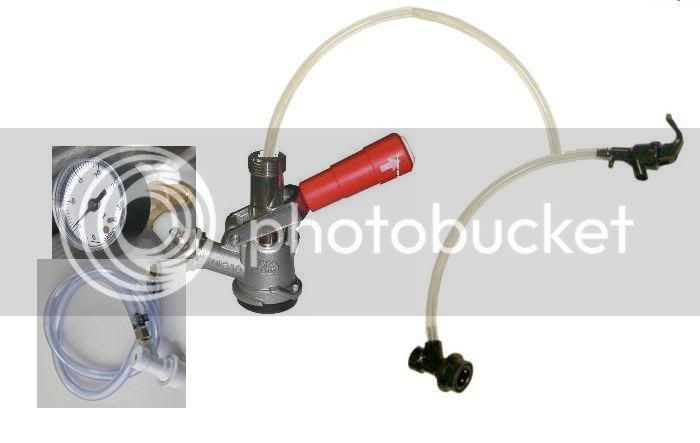.. on a summary (but then how will you find this after it's buried). Mind you, this is my take. Anyone who wants to refute what I'm saying is well, just plain wrong

:
Fermenting under pressure is another tool in the belt. By gradually increasing pressure during primary fermentation, partial or full carbonation can be achieved. This is sometimes referred to in the pro world as 'capping the fermenter' which is kind of a misnomer because pros are using the same tool to achieve it - an adjustable pressure relief valve -aka spunding valve.
{McMaster Carr part #: 99045K44 (for the valve) and 3795K131 (for the stainless glycerin filled gauge to read the pressure). Those are the favored fittings so far. Some people like the 0-60 PSI range, but I like 0-30 PSI range.}
The increased pressure doesn't affect final attenuation but does affect yeast character and can make a beer a little cleaner, making this method something you might want to skip for the belgians (..er not). The increased atmospheric pressure is mimicking the increased hydrostatic pressure that a much larger professional fermenting vessel gives to beer and thus, higher temperatures can be more appropriate for a given yeast as the 'vigor' of the fermentation decreases with pressure, like it does with temperature. This is especially true with the height of the krausen. So, raising the temp as you raise the pressure might be a good idea - especially since this method apparently increases diacetyl production (as well as consumption at the end) and a higher finishing temp might help. Also, decreased krausen permits decreased headroom in primary - i.e. I do 14.5 gallons in a 15.5 gallon Sanke and get about a quart blow-off.
Professional fermenters are usually rated to 15 PSI and not higher like we have with kegs. Chris White says that if you want to ranch for a high number of successive generations, that going beyond 15 PSI in primary fermentation will result in a greater yeast mutation. For homebrew level harvesting and repitching, it's not a problem though as WortMonger has noted. I have yet to repitch more than 3 times before chucking a strain as I don't really ranch yet.
A general fermentation schedule might be to start wide open and 3 days later, after main yeast growth has occurred, crank it up 1-2 PSI every day (obviously depending on the yeast) so that by somewhere's close to the end you are at full (or partial) carbonation for your fermentation temperature. For ales, this means around 35 PSI at 70 degrees. {I go up to 30 PSI only ever as since I keg, I can 'top off' with the tank in the serving vessels no prob, and I appreciate the finer control that the 30's give me.} Beyond that, (and excluding that even), it's yours to have fun experimenting with and all of the pressure fermenters in this cult seem to have their own fermentation schedules that work for them.... like WortMonger and his room temperature lagers = carRRAAAZY!:fro:
Couple tips:
1) Find a way to prohibit krausen from getting all up in your spunding valve. Mine is to use a second pressure vessel (corny) that is ganged to my primary as a blow-off collector- and I put the spunding valve on it. Another way would be to just not fill as high as I do.
2) Your spunding valve has soooo many neat other uses like counterpressure serving keg filling, which you'll do having carb'd beer.
3) You'll get a kick out of slapping on your cobra tap to take a sample for gravity reading. After you cold crash, though, you'll want to find a way to transfer without depressurizing the keg first. This will kick up a lot of yeast from the cake. So, getting down with counterpressure kegging is a must, I think.
4) Why not just serve from the primary? I can say I've done that for a while with no problem as we all know autolysis is the proverbial boogie man. Harvest your yeast after that. It will stay sanitary and cold till then.
Anyhoo. That's my take.


























![Craft A Brew - Safale S-04 Dry Yeast - Fermentis - English Ale Dry Yeast - For English and American Ales and Hard Apple Ciders - Ingredients for Home Brewing - Beer Making Supplies - [1 Pack]](https://m.media-amazon.com/images/I/41fVGNh6JfL._SL500_.jpg)
































